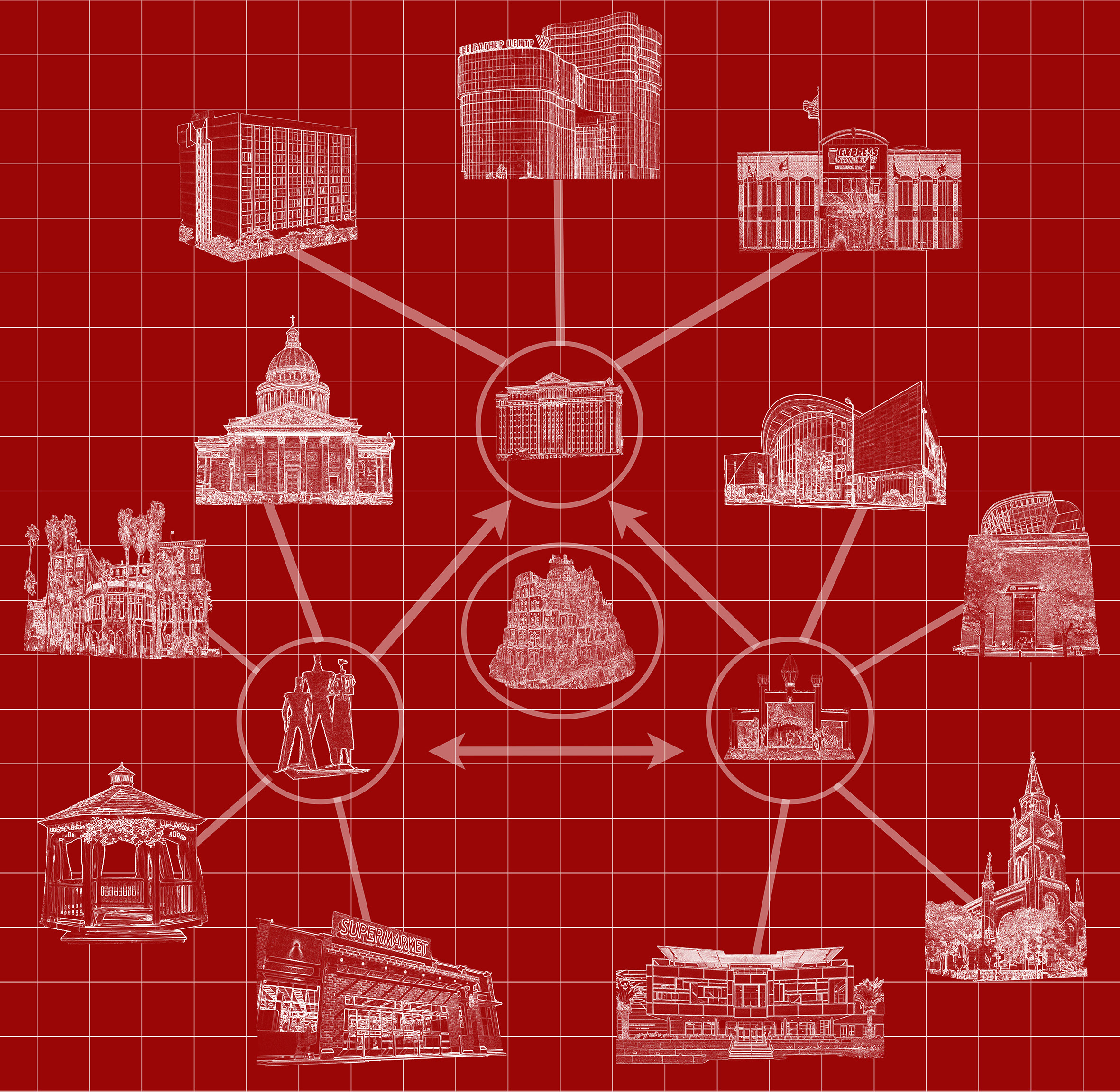
Nick Angelo: La Pensée Unique | Tenki Hiramatsu: Breather
5523 Santa Monica Blvd. Los Angeles, CA 90038
Saturday, May 4 at 6:00 PM – 9:00 PM
Ends Jun 1, 2024
Ends Jun 1, 2024
“Toy garden cities,” Joan Didion once called them, back in 1975. The shopping centers that had been cropping up everywhere in postwar America, she remarked, “float on the landscape like pyramids to the boom years.”1 When her essay “On the Mall” was published, today’s mall magnate and one-time mayoral candidate Rick Caruso was just sixteen years old, a teenager from the Hollywood Hills, himself afloat on daddy’s Dollar Rent-A-Car fortune. But it would be only another ten years before he became the youngest-ever commissioner of Los Angeles Department of Water and Power, and another six before he was appointed president of the city’s Board of Police Commissioners. One year after that, in 2002, Caruso Affiliated Holdings unveiled the Grove, the Imagineered, “pedestrian-oriented,” faux-Deco “lifestyle center” that routinely boasts more annual visitors than Disneyland. “I wanted to create a Main Street for a city that does not have one,” Caruso told Vanity Fair in 2013. “It was very important for me to try to transport people to a better place and time.”2
Boom years and better places: herein lies a uniquely American doctrine, almost always pitching its tent under the marquee of the good old days. The French have a phrase for this. La pensée unique, coined by a French journalist in the ’90s, refers to any political dogma that smuggles itself into public favor under the guise of common sense. The chief example: Margaret Thatcher’s oft-repeated maxim “There is no alternative”—or “TINA”—made to portray the neoliberal free market as the world’s only sensible solution.
The expression is a fitting title for Nick Angelo’s sophomore exhibition with Sebastian Gladstone, expanding the artist’s practice of peeling these exact kinds of precepts apart. Across new paintings, wall graphics, and a two-story miniature diorama sculpture, La Pensée Unique collates many of Angelo’s familiar motifs with renewed vigor. Assembling matrices of crooked rhetoric, sugar-pilled state violence, corporate greenwashing, prisons, precincts, public schools, public sculpture, startups, suburbs, malls, methadone clinics, private gyms, and a scene from Andrei Tarkovsky’s Solaris (1972)—to name a mere few—the exhibition forges connections but avoids easy conclusions, refusing any temptation to tack on a dogma of its own.
Angelo’s style of thinking and making is rhizomatic by nature; try to forge a continuous path and you’ll surely get lost. This is, of course, by design. But in Le Pensée Unique, the Grove is a subtle throughline, winding through the various media like the outdoor mall’s single-track trolley. In TINA Caruso (2024), a painting of a luxe, velvet-curtained movie theater, Angelo supplants the screen at center with a rendering of the Grove’s main thoroughfare at Christmastime. The bedecked trolley car faces the empty seats head-on, as if about to barrel into the fourth wall.The same scene becomes even more real in his sculpture A Celebration of the Union of Dr. Kris Kelvin and TINA Caruso, One for the Ages (2024), restaged as a miniature diorama. Angelo sourced the tiny trolley, patio furnishings, fake foliage, and holiday decor from model-train and dollhouse stores, fashioning a toy garden city of a toy garden city.
What, then, to make of My God, Does He Eat Alone! (After Floris Claesz van Dijck) (2024), a master copy of the Dutch painter’s 1613 composition Still Life with Fruit, Nuts and Cheese? Most of Angelo’s references and reproductions skew more contemporary, urban, architectural, structural. But here is a recreation of a classic breakfast tableau painting, a rather popular convention in Northern Europe during the early seventeenth century. Floris Claesz van Dijck painted during the rapid urbanization of Dutch society; trade was booming and introduced the bourgeoisie to new, rare delicacies and products. Social-climbing patrons strayed from overtly Christian scenes, instead craving bountiful “expression[s] of a certain ostentation.”3 Angelo’s studious attention to the work seems to double the fetish impulse of the original; through his gaze we can glimpse the Dutch Golden Age, the dawn of global capitalism, and the specter of colonialism. In the context of La Pensée Unique, the work points to that era’s prelapsarian optimism, and the people’s belief that they were on the path to a better place and time.
Text by Juliana Halpert
-
1. The paintings of Tenki Hiramatsu are not concerned with narrative, lived experience or allegorical positions. Rather, the figures in his paintings exist as extension of his subconscious impulse—pieces of a puzzle gently or harshly placed together.
2. Perhaps the emotional tenor of these paintings points to their core sentimentality. But pathos is also not Hiramatsu’s main priority.
3. Although the pictures appear immediate and intuitive, the artist contends that an extended amount of viewing is required—his compositions’ spare mark-making belies the hours of quiet examination that the artist dedicates to crafting a casual impression. At a prolonged glance, the internal struggle present within his process comes to the fore.
4. The artist sees the paintings as both abstract and representational—all works begin with a color-field painting—hues of earth, blues, red and green. From there, figures are introduced and removed until a resolution is developed. The artist doesn’t care whether they are legible.
5. The objective of these paintings exists outside of some individual project or plan. Instead, these pictures represent parts of a larger pursuit—a lifetime of dedication to image-making with no regard for its ultimate end. Painting as a choice for living.
- ✨Curate LA Partner
